Thursday 21 June, 2018, 17:42 - Spectrum Management
Posted by Administrator
Posted by Administrator
 Wireless Waffle regularly peruse published data on all manner of radio and related topics to bring you our often orthogonal analyses of various subjects leading to outcomes that others may not have considered. It is with exactly that kind of hat on, that we were looking at the figures produced by Ericsson in its annual Mobility Report. In the report, they give the number of subscribers with a mobile connection, which in 2017 stood at 5.3 billion, up from 5 billion in 2016. This does not include 'machine' subscriptions, nor multiple subscriptions by the same person (i.e. where someone has a phone and a tablet computer, or a work phone and a personal phone) and therefore represents just the number of actual people with a mobile connection.
Wireless Waffle regularly peruse published data on all manner of radio and related topics to bring you our often orthogonal analyses of various subjects leading to outcomes that others may not have considered. It is with exactly that kind of hat on, that we were looking at the figures produced by Ericsson in its annual Mobility Report. In the report, they give the number of subscribers with a mobile connection, which in 2017 stood at 5.3 billion, up from 5 billion in 2016. This does not include 'machine' subscriptions, nor multiple subscriptions by the same person (i.e. where someone has a phone and a tablet computer, or a work phone and a personal phone) and therefore represents just the number of actual people with a mobile connection.The interesting fact from amongst these statistics is that the growth in new mobile subscribers is slowing, and using forecasting based on the 'it fits a nice curve so is probably right' school of highly advanced bistromathics, by 2020, new additions will have fallen to just 1% more than in the previous year reaching around 5.7 billion. World population growth is forecast to be around 1.15% in the same year reaching around 7.8 billion.
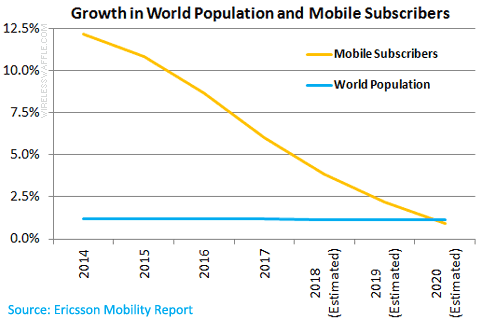
Digging slightly deeper into the figures, what becomes clear is that during 2020, the number of new mobile subscribers will be less than the number of new people on the planet. In 2019, the number of people without a mobile subscription is estimated (by Wireless Waffle) to be 2.08 billion. In 2020 the number of people without a mobile subscription is estimated to be 2.11 billion, or 30 million more.
This is an interesting conclusion. It means that within 2 years, the number of people on the Earth without a mobile subscription will begin to grow. The number of those without access to mobile telecommunications will get bigger. Or put in other terms, the digital divide (between the 'haves' and the 'have nots') will get worse. This appears to be down to two main factors:
 Coverage: Although coverage is still increasing in many countries, it is slowing down. In particular, coverage in rural or remote areas is not changing significantly, as it proves increasingly costly to reach these hard to get to places.
Coverage: Although coverage is still increasing in many countries, it is slowing down. In particular, coverage in rural or remote areas is not changing significantly, as it proves increasingly costly to reach these hard to get to places.- Price: The cost of mobile subscriptions is no longer falling significantly as operators fight to recoup their investments in 3G and 4G. As such, those who can afford a connection already have one, and other than general growth trends increasing the income of the lowest paid, those who cannot afford a connection are unlikely to be able to do so any time soon.
At the same time as the digital divide is set to grow, mobile operators and mobile equipment vendors are hell-bent on introducing new technologies including 5G and millimetre wave. Both these technologies will provide bucket loads of capacity and throughput, but cell sizes are generally going to be limited to a few hundred metres at most, and capacity will be focussed on dense urban areas where there is profit to be made selling such services to data hungry consumers. They are also not cheap and nor will they be incorporated into low-end mobile handsets. The upshot of this is that 5G and millimetre wave technologies will not improve coverage, indeed they will excentuate the urban/rural divide, and they will also do nothing to make services more cost-effective, they will exacurbate the problem.
There is no simple answer to the problems of coverage and price,
 other than mobile operators taking different investment decisions based not necessarily on commercial return, but on providing a public service. Of course they are commercial companies and thus neither obliged nor motivated to become public servants, which is why it might be time for governments to step in. This has happened already in many countries when it comes to investment in fibre, in that a market failure has been identified, and governments have stepped in to fund fibre roll-out to otherwise uneconomical places. The fibre has then been offered on a wholesale basis to anyone who wished to use it.
other than mobile operators taking different investment decisions based not necessarily on commercial return, but on providing a public service. Of course they are commercial companies and thus neither obliged nor motivated to become public servants, which is why it might be time for governments to step in. This has happened already in many countries when it comes to investment in fibre, in that a market failure has been identified, and governments have stepped in to fund fibre roll-out to otherwise uneconomical places. The fibre has then been offered on a wholesale basis to anyone who wished to use it.Maybe the same is now needed for wireless services. The 700 MHz band, for example, is a good candidate to provide rural and remote area coverage at reasonable cost. Instead of auctioning all of the band off to the highest bidder, governments could reserve some (or all) of the band for a national wholesale operator whose target is rural/remote coverage and sell this back to the other operators on a wholesale basis (they could even share the spectrum on a geographic basis with the main operators who could use it in urban/suburban areas). The governments of Mexico and Rwanda are already doing just this, and it makes sense: building just one network in hard to get to places, is, even using basic bistromathics, around four times cheaper than building one network per operator (assuming there are four operators).
One thing that will not solve the problem, is finding yet more radio spectrum for mobile services. Introducing new mobile bands such as those touted at 26 GHz and above, will do absolutely nothing to improve the situation. Today's problem is no longer capacity, it is coverage and price. And spectrum is not the solution, revised government thinking just might be.
1 comment
( 751 views )
| permalink
| 



 ( 3 / 40308 )
( 3 / 40308 )




 ( 3 / 40308 )
( 3 / 40308 )
So many organisations and individuals involved in telecommunications continue to use the term 'exponential' to describe the growth in internet traffic, whether carried on fixed networks, or on wireless. Reports such as the ITU.M... forecast continued exponential growth until 2030 and there are numerous publications that cite growth following an exponential curve. But (with the possible expansion of the universe), nothing grows forever, let alone exponentially.
Let's consider the implications of exponential growth in internet data traffic. According to various sources, the amount of data transferred over the internet in 2018 will reach 1 Zettabyte (or 8x10²¹ bits). If growth continues exponentially at current rates (e.g. around a 50% year-on-year increase), the following things will happen: This is to say nothing of the electrical power requirements. Based on current future expectations of the energy required to transfer a bit of data (around 1 picoJoule per bit), by around 2080 we would need every single Watt of power generated on the planet Earth today to keep the Internet's lights on (let alone the problems of the sizes of batteries that would be needed in mobile devices). By 2113, we would need to capture every milliWatt of power that the Sun emits in order to power the Internet (in essence building a Dyson sphere). Slowly but surely the exponential growth in Internet traffic would begin to consume the whole universe.
This is to say nothing of the electrical power requirements. Based on current future expectations of the energy required to transfer a bit of data (around 1 picoJoule per bit), by around 2080 we would need every single Watt of power generated on the planet Earth today to keep the Internet's lights on (let alone the problems of the sizes of batteries that would be needed in mobile devices). By 2113, we would need to capture every milliWatt of power that the Sun emits in order to power the Internet (in essence building a Dyson sphere). Slowly but surely the exponential growth in Internet traffic would begin to consume the whole universe.
It is therefore to be hoped that the universe is actually infinite and continues to expand (though opinions on this are divided), otherwise it will run out of power before our insatiable demand for watching cat videos is finally sated.
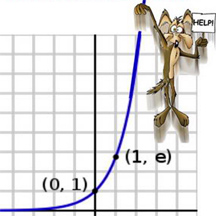 You might wonder what all this has got to do with radio spectrum, as there's always a Wireless Waffle angle on that topic. The simple fact is that although all the energy on the planet may be consumed keeping the Internet going, the amount of radio spectrum required to deliver the speed of connection necessary to transfer that much data will consume all available frequencies far before 2080. This is, of course, the desired goal of the mobile industry!
You might wonder what all this has got to do with radio spectrum, as there's always a Wireless Waffle angle on that topic. The simple fact is that although all the energy on the planet may be consumed keeping the Internet going, the amount of radio spectrum required to deliver the speed of connection necessary to transfer that much data will consume all available frequencies far before 2080. This is, of course, the desired goal of the mobile industry!
As Professor Albert Bartlett of the University of Colorado so aptly puts it:
Let's consider the implications of exponential growth in internet data traffic. According to various sources, the amount of data transferred over the internet in 2018 will reach 1 Zettabyte (or 8x10²¹ bits). If growth continues exponentially at current rates (e.g. around a 50% year-on-year increase), the following things will happen:
 By 2161, the number of bits of data transferred across the internet will equal the number of atoms in a human body.
By 2161, the number of bits of data transferred across the internet will equal the number of atoms in a human body.- By 2229, the number of bits of data transferred across the internet will equal the number of atoms in the planet Earth.
- By 2270, the number of bits of data transferred across the internet will equal the number of atoms in the Solar system.
- By 2329, the number of bits of data transferred across the internet will equal the number of atoms in the Milky Way galaxy (excluding dark matter).
 This is to say nothing of the electrical power requirements. Based on current future expectations of the energy required to transfer a bit of data (around 1 picoJoule per bit), by around 2080 we would need every single Watt of power generated on the planet Earth today to keep the Internet's lights on (let alone the problems of the sizes of batteries that would be needed in mobile devices). By 2113, we would need to capture every milliWatt of power that the Sun emits in order to power the Internet (in essence building a Dyson sphere). Slowly but surely the exponential growth in Internet traffic would begin to consume the whole universe.
This is to say nothing of the electrical power requirements. Based on current future expectations of the energy required to transfer a bit of data (around 1 picoJoule per bit), by around 2080 we would need every single Watt of power generated on the planet Earth today to keep the Internet's lights on (let alone the problems of the sizes of batteries that would be needed in mobile devices). By 2113, we would need to capture every milliWatt of power that the Sun emits in order to power the Internet (in essence building a Dyson sphere). Slowly but surely the exponential growth in Internet traffic would begin to consume the whole universe. It is therefore to be hoped that the universe is actually infinite and continues to expand (though opinions on this are divided), otherwise it will run out of power before our insatiable demand for watching cat videos is finally sated.
 You might wonder what all this has got to do with radio spectrum, as there's always a Wireless Waffle angle on that topic. The simple fact is that although all the energy on the planet may be consumed keeping the Internet going, the amount of radio spectrum required to deliver the speed of connection necessary to transfer that much data will consume all available frequencies far before 2080. This is, of course, the desired goal of the mobile industry!
You might wonder what all this has got to do with radio spectrum, as there's always a Wireless Waffle angle on that topic. The simple fact is that although all the energy on the planet may be consumed keeping the Internet going, the amount of radio spectrum required to deliver the speed of connection necessary to transfer that much data will consume all available frequencies far before 2080. This is, of course, the desired goal of the mobile industry!As Professor Albert Bartlett of the University of Colorado so aptly puts it:
The greatest shortcoming of the human race is our inability to understand the exponential function.
Since his election as President of the United States, one of Donald Trump's key programmes has been the construction of a wall along the border with Mexico. Many people believe that the purpose of such a wall is to reduce illegal immigration along the border and to stop goods being illegally transported between the two countries without clearing the necessary customs.
 Wireless Waffle has discovered, however, that the reason for the construction of the wall is nothing to do with immigration or customs but is needed to prevent transmissions from mobile base stations using the 700 MHz band in Mexico from interfering with mobile base stations in the 700 MHz band in the USA.
Wireless Waffle has discovered, however, that the reason for the construction of the wall is nothing to do with immigration or customs but is needed to prevent transmissions from mobile base stations using the 700 MHz band in Mexico from interfering with mobile base stations in the 700 MHz band in the USA.
It is often said that radio signals do not respect international borders: signals from one country do not abruptly stop when they reach an arbitrary line on a map. As such, signals from mobile base stations in border areas are prone to cause interference to base stations on the opposite side of the border. Several European countries have reached an agreement (known as the HCM Agreement) which defines how much cross-border 'overspill' is permitted.
In general when signals cross borders, the use of the radio spectrum either side of the border is similar, that is to say that if the frequencies are used on one side for base station transmissions, it will be used on the other side for the same purpose. For example, if the signals from one country's mobile base stations are roughly the same strength along the border as those from its neighbour, and assuming that a mobile handset will latch onto the strongest signal, as it passes from one country to the next, it will automatically select the network for the country in which it is located.
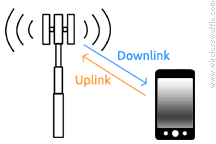 The worst case situation is where the transmitters on one side of the border (the 'downlink') which are typically 1000 Watts or more for a mobile base station are on the same frequencies as the receivers on the other (the 'uplink') which are trying to receive signals from mobile handsets with 1 Watt of power who are several miles away. This is akin to having someone in one country shouting directly into the ear of someone standing next to them who is simulatneously trying to hear one of their own residents whispering to them from a great distance. No manner of technological development will solve this problem and hence neighbouring countries try and avoid this happening.
The worst case situation is where the transmitters on one side of the border (the 'downlink') which are typically 1000 Watts or more for a mobile base station are on the same frequencies as the receivers on the other (the 'uplink') which are trying to receive signals from mobile handsets with 1 Watt of power who are several miles away. This is akin to having someone in one country shouting directly into the ear of someone standing next to them who is simulatneously trying to hear one of their own residents whispering to them from a great distance. No manner of technological development will solve this problem and hence neighbouring countries try and avoid this happening.
Between the US and Mexico in the 700 MHz band, however, this situation arises. The diagram below shows how the frequencies in this mobile band are used in either country. A downlink (mobile base station transmission) on the same frequency as an uplink (mobile base station receive) will cause exactly the kind of problems identified above.

So... the base stations in the 'lower 700 MHz band' in the USA will cause immense interference to the base stations in Mexico operating at the upper end of the Mexican 700 MHz band, and the base stations in Mexico will cause immense interference to the 'upper 700 MHz band' base stations in the USA.
 There is no straightforward solution to this problem, other than one or other country adopting the same frequency plan as its neighbour. As both countries already have services operating in the bands, this is beyond unlikely. The only way to overcome such a problem is therefore to try and stop signals from one side of the border reaching the other side. The laws of physics dictate that the only way to do this is to build a barrier that is impervious to radio signals, such as, for example, a tall metallic wall (or one with metal running up the inside). Metal boxes known as Faraday cages are used in laboratories (and sci-fi movies) to perform just this task.
There is no straightforward solution to this problem, other than one or other country adopting the same frequency plan as its neighbour. As both countries already have services operating in the bands, this is beyond unlikely. The only way to overcome such a problem is therefore to try and stop signals from one side of the border reaching the other side. The laws of physics dictate that the only way to do this is to build a barrier that is impervious to radio signals, such as, for example, a tall metallic wall (or one with metal running up the inside). Metal boxes known as Faraday cages are used in laboratories (and sci-fi movies) to perform just this task.
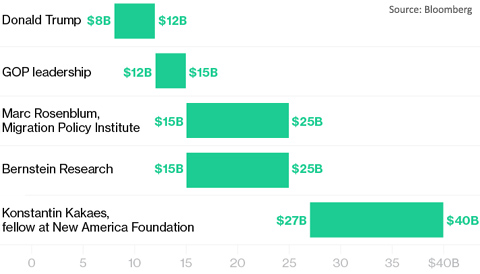
The 700 MHz band was sold at auction in the USA for US$19 billion in 2008. Estimates of the cost of the wall vary, but the mean value is around US$20 billion. This is no co-incidence. Having paid US$19 billion for the spectrum in the 700 MHz band, the US operators have a reasonable expectation that they can use the frequencies without undue interference and thus a 'Faraday Wall' is necessary. As long as Mr Trump can build it for less than US$19 billion, the operators will be happy, and the Federal Reserve will still have made a small profit on the sale of the spectrum. Win-win as they say.
 Wireless Waffle has discovered, however, that the reason for the construction of the wall is nothing to do with immigration or customs but is needed to prevent transmissions from mobile base stations using the 700 MHz band in Mexico from interfering with mobile base stations in the 700 MHz band in the USA.
Wireless Waffle has discovered, however, that the reason for the construction of the wall is nothing to do with immigration or customs but is needed to prevent transmissions from mobile base stations using the 700 MHz band in Mexico from interfering with mobile base stations in the 700 MHz band in the USA.It is often said that radio signals do not respect international borders: signals from one country do not abruptly stop when they reach an arbitrary line on a map. As such, signals from mobile base stations in border areas are prone to cause interference to base stations on the opposite side of the border. Several European countries have reached an agreement (known as the HCM Agreement) which defines how much cross-border 'overspill' is permitted.
In general when signals cross borders, the use of the radio spectrum either side of the border is similar, that is to say that if the frequencies are used on one side for base station transmissions, it will be used on the other side for the same purpose. For example, if the signals from one country's mobile base stations are roughly the same strength along the border as those from its neighbour, and assuming that a mobile handset will latch onto the strongest signal, as it passes from one country to the next, it will automatically select the network for the country in which it is located.
 The worst case situation is where the transmitters on one side of the border (the 'downlink') which are typically 1000 Watts or more for a mobile base station are on the same frequencies as the receivers on the other (the 'uplink') which are trying to receive signals from mobile handsets with 1 Watt of power who are several miles away. This is akin to having someone in one country shouting directly into the ear of someone standing next to them who is simulatneously trying to hear one of their own residents whispering to them from a great distance. No manner of technological development will solve this problem and hence neighbouring countries try and avoid this happening.
The worst case situation is where the transmitters on one side of the border (the 'downlink') which are typically 1000 Watts or more for a mobile base station are on the same frequencies as the receivers on the other (the 'uplink') which are trying to receive signals from mobile handsets with 1 Watt of power who are several miles away. This is akin to having someone in one country shouting directly into the ear of someone standing next to them who is simulatneously trying to hear one of their own residents whispering to them from a great distance. No manner of technological development will solve this problem and hence neighbouring countries try and avoid this happening. Between the US and Mexico in the 700 MHz band, however, this situation arises. The diagram below shows how the frequencies in this mobile band are used in either country. A downlink (mobile base station transmission) on the same frequency as an uplink (mobile base station receive) will cause exactly the kind of problems identified above.

So... the base stations in the 'lower 700 MHz band' in the USA will cause immense interference to the base stations in Mexico operating at the upper end of the Mexican 700 MHz band, and the base stations in Mexico will cause immense interference to the 'upper 700 MHz band' base stations in the USA.
 There is no straightforward solution to this problem, other than one or other country adopting the same frequency plan as its neighbour. As both countries already have services operating in the bands, this is beyond unlikely. The only way to overcome such a problem is therefore to try and stop signals from one side of the border reaching the other side. The laws of physics dictate that the only way to do this is to build a barrier that is impervious to radio signals, such as, for example, a tall metallic wall (or one with metal running up the inside). Metal boxes known as Faraday cages are used in laboratories (and sci-fi movies) to perform just this task.
There is no straightforward solution to this problem, other than one or other country adopting the same frequency plan as its neighbour. As both countries already have services operating in the bands, this is beyond unlikely. The only way to overcome such a problem is therefore to try and stop signals from one side of the border reaching the other side. The laws of physics dictate that the only way to do this is to build a barrier that is impervious to radio signals, such as, for example, a tall metallic wall (or one with metal running up the inside). Metal boxes known as Faraday cages are used in laboratories (and sci-fi movies) to perform just this task. 
The 700 MHz band was sold at auction in the USA for US$19 billion in 2008. Estimates of the cost of the wall vary, but the mean value is around US$20 billion. This is no co-incidence. Having paid US$19 billion for the spectrum in the 700 MHz band, the US operators have a reasonable expectation that they can use the frequencies without undue interference and thus a 'Faraday Wall' is necessary. As long as Mr Trump can build it for less than US$19 billion, the operators will be happy, and the Federal Reserve will still have made a small profit on the sale of the spectrum. Win-win as they say.
Back in December when we discussed the launch of Radio Caroline on 648 kHz and suggested that they were using wider bandwidth AM, Mike left a comment concerning Stereo AM. Stereo AM makes a great article for a post, so here we go!
AM broadcasting in the medium-wave (MW) band is traditionally mono only. Back in the early 1980's four competing technologies were running trials of AM stereo, and in 1988 a solution proposed by Motorola called Compatible-Quadrature Amplitude Modulation (C-QUAM) which had gained significant popularity, was chosen as the de-facto standard in the USA (it was formally adopted in 1993). The word 'compatible' refers to the fact that one of the primary criteria for the solution was that an 'old fashioned' mono AM receiver would not notice any difference when tuned to an AM-stereo signal, that is to say that it would continue to receive a mono signal as if nothing had changed. Thus the stereo signal would remain compatible with mono receivers (note that exactly the same is true of FM stereo).
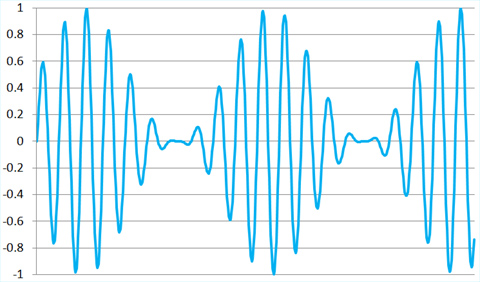 The C-QUAM solution used the properties of AM and of FM to do something novel. In an AM waveform (as shown on the right), the information (in this case audio) is imposed onto the transmission frequency (the 'carrier wave') by changing the amount of power transmitted, that is to say, changing the amplitude of the transmission and hence amplitude modulation (AM). At the receiver, only the amplitude of the signal is used to recover the data.
The C-QUAM solution used the properties of AM and of FM to do something novel. In an AM waveform (as shown on the right), the information (in this case audio) is imposed onto the transmission frequency (the 'carrier wave') by changing the amount of power transmitted, that is to say, changing the amplitude of the transmission and hence amplitude modulation (AM). At the receiver, only the amplitude of the signal is used to recover the data.
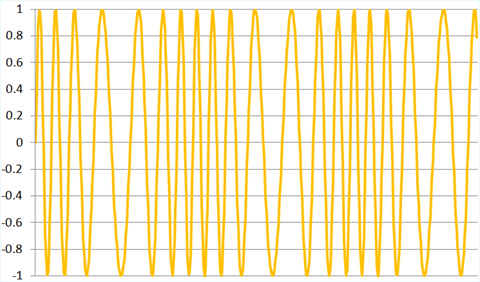 For an FM system, the amplitude or power of the transmitter remains the same and only the frequency is varied, hence frequency modulation (FM). In reality, the amplitude of the signal at the receiver will often vary, especially if the receiver is mobile, but as long as the signal that arrives at the receiver is strong enough to overcome any background noise, the receiver will still be able to detect what frequency was being transmitted and recover the original data or audio.
For an FM system, the amplitude or power of the transmitter remains the same and only the frequency is varied, hence frequency modulation (FM). In reality, the amplitude of the signal at the receiver will often vary, especially if the receiver is mobile, but as long as the signal that arrives at the receiver is strong enough to overcome any background noise, the receiver will still be able to detect what frequency was being transmitted and recover the original data or audio.
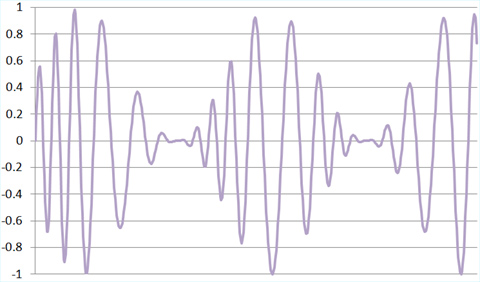 What Motorola did was to use both FM and AM at the same time. It is not as easy to see what is going on in the C-QUAM waveform shown on the right, but the principle is fairly straightforward. If you feed this signal into an AM receiver, it will only detect the changes in amplitude and will ignore the changes in frequency completely. If you feed this signal into an FM receiver, the opposite happens and the AM part of the signal is ignored and only the information modulated on the FM part of the signal is decoded. Hence you can send two sets of information at the same time, one using AM and the other FM.
What Motorola did was to use both FM and AM at the same time. It is not as easy to see what is going on in the C-QUAM waveform shown on the right, but the principle is fairly straightforward. If you feed this signal into an AM receiver, it will only detect the changes in amplitude and will ignore the changes in frequency completely. If you feed this signal into an FM receiver, the opposite happens and the AM part of the signal is ignored and only the information modulated on the FM part of the signal is decoded. Hence you can send two sets of information at the same time, one using AM and the other FM.
Compatibility is maintained by sending the Left and Right signals added together on the AM element of the transmission, and the 'stereo difference' (Left minus Right) on the FM part. Thus a mono AM receiver will see no change, but a stereo FM receiver will be able to add the mono and difference signals together to recover the original stereo signal. This is the same principle that applies for stereo FM broadcasting, though the method of transmitting the sum and difference signals are different.
The C-QUAM system is actually a little more complex than the description I have given above, for example, a pilot signal is added into the FM part of the signal to alert receivers that the transmission they are receiving is in C-QUAM, but the logic is in principle the same.
There are lots of videos of C-QUAM AM stereo on YouTube, but the one below is perhaps one of the best illustrations of what it sounds like on-air. It's actually fairly impressive.
So why is it that you've probably never heard of Stereo AM before? Here are some thoughts:
AM broadcasting in the medium-wave (MW) band is traditionally mono only. Back in the early 1980's four competing technologies were running trials of AM stereo, and in 1988 a solution proposed by Motorola called Compatible-Quadrature Amplitude Modulation (C-QUAM) which had gained significant popularity, was chosen as the de-facto standard in the USA (it was formally adopted in 1993). The word 'compatible' refers to the fact that one of the primary criteria for the solution was that an 'old fashioned' mono AM receiver would not notice any difference when tuned to an AM-stereo signal, that is to say that it would continue to receive a mono signal as if nothing had changed. Thus the stereo signal would remain compatible with mono receivers (note that exactly the same is true of FM stereo).
 The C-QUAM solution used the properties of AM and of FM to do something novel. In an AM waveform (as shown on the right), the information (in this case audio) is imposed onto the transmission frequency (the 'carrier wave') by changing the amount of power transmitted, that is to say, changing the amplitude of the transmission and hence amplitude modulation (AM). At the receiver, only the amplitude of the signal is used to recover the data.
The C-QUAM solution used the properties of AM and of FM to do something novel. In an AM waveform (as shown on the right), the information (in this case audio) is imposed onto the transmission frequency (the 'carrier wave') by changing the amount of power transmitted, that is to say, changing the amplitude of the transmission and hence amplitude modulation (AM). At the receiver, only the amplitude of the signal is used to recover the data. For an FM system, the amplitude or power of the transmitter remains the same and only the frequency is varied, hence frequency modulation (FM). In reality, the amplitude of the signal at the receiver will often vary, especially if the receiver is mobile, but as long as the signal that arrives at the receiver is strong enough to overcome any background noise, the receiver will still be able to detect what frequency was being transmitted and recover the original data or audio.
For an FM system, the amplitude or power of the transmitter remains the same and only the frequency is varied, hence frequency modulation (FM). In reality, the amplitude of the signal at the receiver will often vary, especially if the receiver is mobile, but as long as the signal that arrives at the receiver is strong enough to overcome any background noise, the receiver will still be able to detect what frequency was being transmitted and recover the original data or audio. What Motorola did was to use both FM and AM at the same time. It is not as easy to see what is going on in the C-QUAM waveform shown on the right, but the principle is fairly straightforward. If you feed this signal into an AM receiver, it will only detect the changes in amplitude and will ignore the changes in frequency completely. If you feed this signal into an FM receiver, the opposite happens and the AM part of the signal is ignored and only the information modulated on the FM part of the signal is decoded. Hence you can send two sets of information at the same time, one using AM and the other FM.
What Motorola did was to use both FM and AM at the same time. It is not as easy to see what is going on in the C-QUAM waveform shown on the right, but the principle is fairly straightforward. If you feed this signal into an AM receiver, it will only detect the changes in amplitude and will ignore the changes in frequency completely. If you feed this signal into an FM receiver, the opposite happens and the AM part of the signal is ignored and only the information modulated on the FM part of the signal is decoded. Hence you can send two sets of information at the same time, one using AM and the other FM.Compatibility is maintained by sending the Left and Right signals added together on the AM element of the transmission, and the 'stereo difference' (Left minus Right) on the FM part. Thus a mono AM receiver will see no change, but a stereo FM receiver will be able to add the mono and difference signals together to recover the original stereo signal. This is the same principle that applies for stereo FM broadcasting, though the method of transmitting the sum and difference signals are different.
The C-QUAM system is actually a little more complex than the description I have given above, for example, a pilot signal is added into the FM part of the signal to alert receivers that the transmission they are receiving is in C-QUAM, but the logic is in principle the same.
There are lots of videos of C-QUAM AM stereo on YouTube, but the one below is perhaps one of the best illustrations of what it sounds like on-air. It's actually fairly impressive.
So why is it that you've probably never heard of Stereo AM before? Here are some thoughts:
- Though a number of stations (particularly in the USA, Canada, Japan and Australia) did adopt the standard, there may have been insufficient stations on-air for consumers to properly experience the difference.
- The cost of receivers was always higher than mono ones as they were far more complex. This was exacerbated for a while as Motorola held the patents for the system and would have charged manufacturers a handsome fee to adopt it (they were forced to remove such payments in 1993 in the US when the FCC formally adopted the system).
- The quality of transmission of AM stereo, though better than AM mono, was not competitive with FM stereo which, by the time the C-QUAM standard had been adopted, were far more widespread than when the original AM stereo trials began.
- Maybe, and this is just supposition, the types of station on AM were in themselves less popular than the growing FM market, or possibly in some cases the programme material (e.g. talk) was not well suited to stereo.

